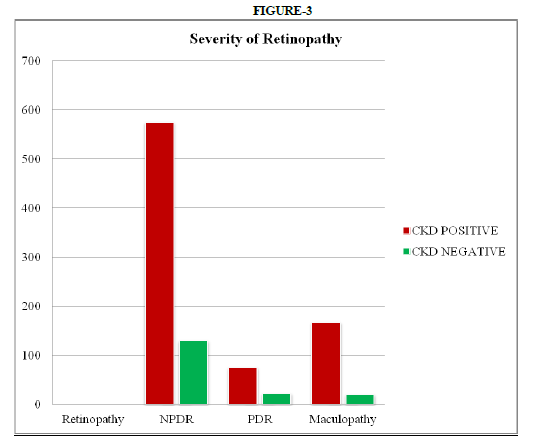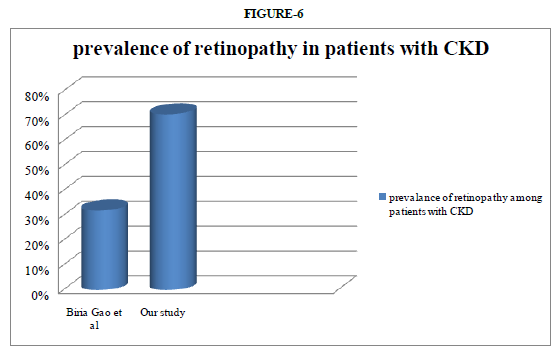IJCRR - 5(23), December, 2013
Pages: 13-20
Date of Publication: 16-Dec-2013
Print Article
Download XML Download PDF
PREVALENCE OF RETINAL MICROVASCULAR ABNORMALITIES IN PATIENTS WITH CHRONIC KIDNEY DISEASE AMONG DIABETIC POPULATION
Author: Narendra P. Datti, K. Kanthamani, B.N. Raghavendra Prasad, Krishnamurthy Donthi, Manasa Korthiwada
Category: Healthcare
Abstract:Purpose: To study prevalence of retinal microvascular abnormalities in patients with Chronic Kidney Disease(CKD) among diabetic population Methods: All known cases of Type II diabetes mellitus patients attending R.L.J. Hospital, Kolar between january and december 2011 were subjected to complete renal and ophthalmic evaluation. The diagnosis of CKD was done based on the presence of contracted kidney on abdominal ultrasonography and microalbuminuria. Ocular fundus examination was performed by an ophthalmologist. Results: A total of 2094 Type II diabetic patients were examined. Among them 920(44%) patients had CKD. Of these, 650(70.7%) patients had diabetic retinopathy. Among them, 575(88.5%) had Non Proliferative Diabetic retinopathy(NPDR), 75(11.5%) had Proliferative Diabetic retinopathy(PDR) , 167(25.7%) had Diabetic maculopathy, 74(11.4%) had Hypertensive retinopathy and 37(5.7%) had Age related macular degeneration. Among patients without CKD (1174), 152 had diabetic retinopathy (13%). Among them 130(85.5%) had NPDR, 22(14.5%) had PDR and 20(13%) had Diabetic maculopathy. Compared to patients without CKD, patients with CKD had higher prevalence of retinopathy(p< 0.0001) Conclusion: In our study, we found a high prevalence of retinal microvascular abnormalities in patients with CKD, which warrants for regular complete eye examinations in CKD population.
Keywords: Diabetes, microalbuminuria, CKD, diabetic retinopathy.
Full Text:
INTRODUCTION
Diabetes is one of the most common metabolic diseases in which insulin is lacking or the body’s cells are insensitive to its effects[1]. Diabetes mellitus (DM) due to its effect on small and large blood vessels is known to cause various microvascular and macrovascular complications. The incidence of microvascular complications namely nephropathy, retinopathy and neuropathy increase with duration of diabetes[2].
Diabetic Retinopathy (DR) is the most common microvascular complication of diabetes and leading cause of acquired blindness. The burden of DR is increasing with the rising prevalence of type2 DM[3].
Microalbuminuria (MA) seems to reflect a state of pathophysiological vascular dysfunction that makes an individual susceptible to organ damage. Persistence of MA in diabetes patients is a risk marker not only for kidney and cardiac disorders but also for severe ocular morbidity[3].
The two most common causes of chronic kidney disease (CKD) and end stage renal disease are diabetes mellitus and hypertensive nephrosclerosis[4]. Several studies have shown correlation between retinopathy and nephropathy changes in diabetes, in systemic hypertension and in individuals without these two conditions[5].
The main aim of our study is to detect prevalence of retinal microvascular abnormalities in patients with Chronic Kidney Disease (CKD) among diabetic population visiting a tertiary care hospital.
MATERIALS AND METHODS
Study Design
This retrospective randomized study was conducted on 2094 type2 diabetic patients attending R. L. Jalappa Hospital, Kolar, Karnataka from January-December2011.
Patient Selection
The study was approved by Institutional ethics committee of SDUMC and the selected patients fulfilling the inclusion criteria were enrolled in the study. Inclusion criteria being all diabetic patients and exclusion criteria being patients with acute and chronic infections, collagen vascular disorders and malignancies and any other pre existing ocular diseases.
All patients were subjected to complete renal and ophthalmic evaluation which included serum creatinine, abdominal ultrasonography, 24 hr urine albumin levels and direct and indirect ophthalmoscopy .
Type2 Diabetes mellitus was defined as Fasting blood glucose of>126mg/dl or Random blood sugar of>200mg/dl with symptoms of diabetes. Microalbuminuria is defined by the presence of 30-300mg of albumin in a 24hr urine sample.The diagnosis of CKD was done based on the presence of contracted kidney on abdominal ultrasonography and microalbuminuria and Retinopathy changes were diagnosed by the presence of microaneurysms, cotton wool spots, dot and blot haemorrhages, hard exudates, intra retinal microvascular abnormalities and neovascularisation of retina.
Retinopathy changes are graded based on ETDRS classification.
STATISTICAL ANALYSIS
Statistical analysis was done using chi-square test for qualitative analysis. For statistical calculation SPSS for windows statistical packages with general significance of a p value<0.05 was used.
RESULTS
In our study,2094 type2 diabetic patients were examined during the study period. Patients were comparable for age and sex. Among them 920(44%) patients had CKD and 1174(66%) patients were without CKD [Table-1] [Figure-1]. Among 920 CKD patients, 650(70.7%) patients had Diabetic Retinopathy (DR) and 270(29.3%) patients had no retinopathy. [Table-2] [Figure-2]. Grading of retinopathy was done using ETDRS classification. Among 650 DR patients,575(88.5%) had Non-Proliferative Diabetic Retinopathy(NPDR), 75(11.5%) had Proliferative Diabetic Retinopathy(PDR) ,167(25.7%) had Diabetic maculopathy[Table-3][Figure-3], 74(11.4%) had Hypertensive retinopathy and 37(5.7%) had Age related macular degeneration.
Among 575(88.5%) NPDR patients, 220(33.8%) patients had mild NPDR , 130(20%) had moderate NPDR and 225(34.6%) had severe NPDR.[Figure-4]
Among 1174(66%) patients without CKD, 152(13%) patients had Diabetic Retinopathy(DR), 1022(87%) patients had no retinopathy. Among 152 DR patients, 130(85.5%) had NPDR, 22(14.5%) had PDR and 20(13%) patients had diabetic maculopathy.
Among 130(85.5%) NPDR patients, 65(50%) patients had mild NPDR, 43(33%) had moderate NPDR and 22(16%) had severe NPDR.
In our study, compared to patients without CKD, patients with CKD had higher prevalence of retinopathy (p<0.0001).
DISCUSSION
TypeII Diabetes Mellitus is an emerging global epidemic and its incidence has increased dramatically in the last decade. Diabetes mellitus (DM) due to its effect on small and large blood vessels is known to cause various microvascular and macrovascular complications. The incidence of microvascular complications namely nephropathy, retinopathy and neuropathy increase with duration of diabetes[2].Diabetic nephropathy occurs in about one-third of patients with either type1 or type2 diabetes and adds enormously to the morbidity, mortality and cost of treatment[6]. Each year 3.2 million deaths globally are attributed to diabetes. The incidence of blindness is 25 times higher in persons with diabetes than the general population. Every patient with diabetes will eventually develop diabetic retinopathy with an incidence between 25-44%.
The incidence and prevalence of kidney failure caused by diabetes are rising and its outcome is poor[9]. Diabetes is often associated with CKD and about 45% of patients who receive dialysis therapy, the primary cause of their kidney failure is diabetes[12]. Moderate to severe CKD is estimated to be found in 15-23% of patients with diabetes[Figure-5]. CKD is a common condition that is estimated to affect >50 million people world wide[13].
The impact of combination of diabetes and CKD is important because the risk of events and death from cardiovascular disease is significantly higher compared to patients without the combination of both[14,15].
The clinical diagnosis of CKD is primarily identified by detection of proteinuria. For initial screening of diabetic kidney disease, measurement of spot urine collection for proteinuria rather than a 24 hour urine collection is recommended because the albumin-creatinine ratio by spot urine sample has demonstrated excellent correlation with the 24 hour urine protein measurement[12].
Microvascular disease has been hypothesized to contribute to the development of chronic kidney disease particularly among persons with known microvascular risk factors[10]. Study done by Wong TY et al had shown that the retinal microvasculature represented by retinal arterioles and venules allows for non invasive visualization of systemic microcirculation and thus, retinal vessel changes may serve as markers of pre clinical stages of systemic microvascular disease[11].
Several types of ocular fundus pathology have been associated with CKD, one of the best studied is the association between retinal microvascular abnormalities and CKD. In a cross sectional study from Singapore, both retinal arteriolar diameter and retinopathy was found to be independently associated with presence of CKD[7].
A large proportion of patients with renal impairment do not have evidence of primary renal failure. In these patients, vascular diseases involving the renal microcirculation have been hypothesized as one of the possible causes of early decline in renal function. Evidence to support such a hypothesis is derived from experimental studies of microvascular alterations in the renal circulation in chronic renal failure and the strong link between kidney disease and vascular risk factors such as diabetes and hypertension[8]. In our study we found that 44% of diabetic patients had CKD.
In our study, it was seen that patients with CKD had higher prevalence of retinopathy (70.7%) compared to patients without CKD (13%) [p<0.0001]. This was comparable to the results of cross sectional study of Biria Gao et al where the prevalence of overall ocular fundus pathology was found to be 32% among participants with CKD and was significantly higher than that of participants without CKD[7].[Figure-6].
The main cause of blindness in CKD patients is due to proliferative diabetic retinopathy and maculopathy. In our study, we found 11.5% patients with CKD had proliferative diabetic retinopathy and 25.7% patients had diabetic maculopathy among CKD patients.
The main limitation of our study is, eventhough in our study, we found large number of patients with retinal changes in CKD population, population based studies need to be undertaken to ascertain the magnitude of CKD and ocular complication in type II diabetics.
CONCLUSION
In our study as we found strong association between retinal microvascular abnormalities and renal dysfunction which warrants for regular complete eye examinations in patients with renal disease. Our findings support the hypothesis that microvascular disease may be important in the pathogenesis of renal dysfunction in the community.







References:
- Manaviat MR, Afkhami M, Shoja MR. Retinopathy and microalbuminuria in type II diabetic patients. BMC Ophthalmology 2004;4:1471-2415.
- Chandy A, Pawar B, John M, Isaac R. Association between Diabetic Nephropathy and Other Diabetic Microvascular and Macrovascular Complications. Saudi J Kidney Dis Transplant 2008;19:924-928.
- 3)Chen H, Zheng Z, Huang Y, Guo K, Lu J, Zhang L, et al. A Microalbuminuria Threshold to Predict the Risk for the Development of Diabetic Retinopathy in Type 2 Diabetes Mellitus Patients. PLoS ONE 2012; 7:e36718.
- Edwards MS, Wilson DB, Craven TE, Stafford J, Fried LF, Wong TY, et al. Associations Between Retinal Microvascular Abnormalities and Declining Renal Function in the Elderly Population: The Cardiovascular Health Study. American Journal of Kidney Diseases2005;46:214-224.
- Grunwald JE, Alexander J, Maguire M, Whittock R, Parker C, McWilliams K, et al. Prevalence of Ocular Fundus Pathology in Patients with Chronic Kidney Disease. Clin J Am Soc Nephrol. 2010;5:867-873.
- Prakash J, Lodha M, Singh SK, Vohra R, Raja R, Usha. Diabetic Retinopathy is A Poor Predictor of Type of Nephropathy in Proteinuric Type 2 Diabetic Patients. JAPI 2007;55:412-416.
- Gao B, Zhu L, Pan Y, Yang S, Zhang L, Wang H. Ocular fundus pathology and chronic kidney disease in a Chinese population. BMC Nephrology 2011;12:62.
- Wong TY, Coresh J, Klein R, Muntner P, Couper DJ, Sharrett AR, et al. Retinal Microvascular Abnormalities and Renal Dysfunction: The Atherosclerosis Risk in Communities Study. J Am Soc Nephrol;15:2469-2476.
- Lu B, Song X, Dong X, Yang Y, Zhang Z, Wen J, et al. High prevalence of chronic kidney disease in population-based patients diagnosed with type 2 diabetes in downtown Shanghai. Journal of Diabetes and Its Complications 2008;22:96-103.
- Sabanayagam C, Shankar A, Koh D, Chia KS, Saw SM, Lim SC, et al. Retinal Microvascular Caliber and Chronic Kidney Disease in an Asian Population. Am J Epidemiol 2009; 169: 625-32.
- Wong TY, McIntosh R. Systemic associations of retinal microvascular signs: a review of recent population-based studies. Ophthalmic Physiol Opt. 2005;25:195-204.
- Cavanaugh KL. CLINICAL DIABETES 2007; 25:90-7.
- Coresh J, Byrd-Holt D, Astor BC, Briggs JP, Eggers PW, Lacher DA, et al. Chronic kidney disease awareness, prevalence, and trends among U.S. adults. J Am Soc Nephrol 2005;16:180–8.
- Foley RN, Murray AM, Li S, Herzog CA, McBean AM, Eggers PW, et al. Chronic kidney disease and the risk for cardiovascular disease, renal replacement, and death in the United States Medicare population. J Am Soc Nephrol 2005;16:489–95.
- Valmadrid CT, Klein R, Moss SE, Klein BE.The risk of cardiovascular disease mortality associated with microalbuminuria and gross proteinuria in persons with older-onset diabetes mellitus. ArchIntern Med 2000;160:1093–1100.
|






 This work is licensed under a Creative Commons Attribution-NonCommercial 4.0 International License
This work is licensed under a Creative Commons Attribution-NonCommercial 4.0 International License